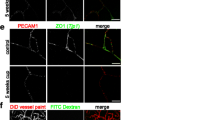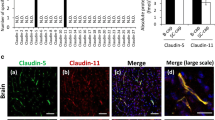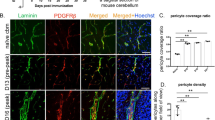Abstract
In multiple sclerosis (MS), and its animal model experimental autoimmune encephalomyelitis (EAE), dysfunction of the blood–brain barrier (BBB) leads to edema formation within the central nervous system. The molecular mechanisms of edema formation in EAE/MS are poorly understood. We hypothesized that edema formation is due to imbalanced water transport across the BBB caused by a disturbed crosstalk between BBB endothelium and astrocytes. Here, we demonstrate at the light microscopic and ultrastructural level, the loss of polarized localization of the water channel protein aquaporin-4 (AQP4) in astrocytic endfeet surrounding microvessels during EAE. AQP4 was found to be redistributed over the entire astrocytic cell surface and lost its arrangement in orthogonal arrays of intramembranous particles as seen in the freeze-fracture replica. In addition, immunostaining for the astrocytic extracellular matrix receptor β-dystroglycan disappeared from astroglial membranes in the vicinity of inflammatory cuffs, whereas immunostaining for the dystroglycan ligands agrin and laminin in the perivascular basement membrane remained unchanged. Our data suggest that during EAE, loss of β-dystroglycan-mediated astrocyte foot process anchoring to the basement membrane leads to loss of polarized AQP4 localization in astrocytic endfeet, and thus to edema formation in EAE.









Similar content being viewed by others
References
Agrawal S, Anderson P, Durbeej M, Van Rooijen N, Ivars F, Opdenakker G, Sorokin LM (2006) Dystroglycan is selectively cleaved at the parenchymal basement membrane at sites of leukocyte extravasation in experimental autoimmune encephalomyelitis. J Exp Med 203:1007–1019
Amiry-Moghaddam M, Otsuka T, Hurn PD, Traystman RJ, Haug F-M, Froehner SC, Adams ME, Neely JD, Agre P, Ottersen OP, Bhardwaj A (2003) An α-syntrophin-dependent pool of AQP4 in astroglial end-feet confers bidirectional water flow between blood and brain. Proc Natl Acad Sci USA 100:2106–2111
Aoki-Yoshino K, Uchihara T, Duyckaerts C, Nakamura A, Hauw J-J, Wakayama Y (2005) Enhanced expression of aquaporin 4 in human brain with inflammatory diseases. Acta Neuropathol 110:281–288
Barber AJ, Lieth E (1997) Agrin accumulates in the brain microvascular basal lamina during development of the blood–brain barrier. Dev Dyn 208:62–74
Calogero A, Pavoni E, Gramaglia T, D’Amati G, Ragona G, Brancaccio A, Petrucci TC (2006) Altered expression of α-dystroglycan subunit in human gliomas. Cancer Biol Therapy 5:441–448
Furman CS, Gorelick-Feldman DA, Davidson KGV, Yasumura T, Neely JD, Agre P, Rash JE (2003) Aquaporin-4 square array assembly: opposing actions of M1 and M23 isoforms. Proc Natl Acad Sci USA 100:13609–13614
Holt KH, Crosbie RH, Venzke DP, Campbell KP (2000) Biosynthesis of dystroglycan: processing of a precursor propeptide. FEBS Lett 468:79–83
Jung JS, Bhat RV, Preston GM, Guggino WB, Baraban JM, Agre P (1994) Molecular characterization of an aquaporin cDNA from brain: candidate osmoreceptor and regulator of water balance. Proc Natl Acad Sci USA 91:13052–13056
Kniesel U, Wolburg H (2000) Tight junctions of the blood–brain barrier. Cell Mol Neurobiol 20:57–76
Lennon VA, Kryzer TJ, Pittock SJ, Verkman AS, Hinson SR (2005) IgG marker of optic-spinal multiple sclerosis binds to the aquaporin-4 water channel. J Exp Med 202:473–477
Liebner S, Fischmann A, Rascher G, Duffner F, Grote E-H, Kalbacher H, Wolburg H (2000) Claudin-1 and claudin-5 expression and tight junction morphology are altered in blood vessels of human glioblastoma multiforme. Acta Neuropathol 100:323–331
Lindahl P, Johansson BR, Levéen P, Betsholtz C (1997) Pericyte loss and microaneurysm formation in PDGF-B-deficient mice. Science 277:242–245
Moe SE, Sorbo JG, Sogaard R, Zeuthen T, Ottersen OP, Holen T (2008) New isoforms of rat aquaporin-4. Genomics 91:367–377
Moore SA, Saito F, Chen J, Michele DE, Henry MD, Messing A, Cohn RD, Ross-Barta SE, Westra S, Williamson RA, Hoshi T, Campbell KP (2002) Deletion of brain dystroglycan recapitulates aspects of congenital muscular dystrophy. Nature 418:422–425
Nag S (1996) Cold-injury of the cerebral cortex: immunolocalization of cellular proteins and blood–brain barrier permeability studies. J Neuropathol Exp Neurol 55:880–888
Nagelhus EA, Mathisen TM, Ottersen OP (2004) Aquaporin-4 in the central nervous system: cellular and subcellular distribution and coexpression with Kir4.1. Neuroscience 129:905–913
Neely JD, Amiry-Moghaddam M, Ottersen OP, Froehner SC, Agre P, Adams ME (2001) Syntrophin-dependent expression and localization of aquaporin-4 water channel protein. Proc Natl Acad Sci USA 98:14108–14113
Neuhaus J (1990) Orthogonal arrays of particles in astroglial cells: quantitative analysis of their density, size, and correlation with intramembranous particles. Glia 3:241–251
Noell S, Fallier-Becker P, Beyer C, Kröger S, Mack AF, Wolburg H (2007) Effects of agrin on the expression and distribution of the water channel protein aquaporin-4 and volume regulation in cultured astrocytes. Eur J Neurosci 26:2109–2118
Noell S, Fallier-Becker P, Deutsch U, Mack AF, Wolburg H (2009) Agrin defines polarized distribution of orthogonal arrays of particles in astrocytes. Cell Tissue Res (in press)
Rascher G, Fischmann A, Kröger S, Duffner F, Grote E-H, Wolburg H (2002) Extracellular matrix and the blood–brain barrier in glioblastoma multiforme: spatial segregation of tenascin and agrin. Acta Neuropathol 104:85–91
Rash JE, Davidson KGV, Yasumura T, Furman CS (2004) Freeze-fracture and immunogold analysis of aquaporin-4 (AQP4) square arrays, with models of AQP4 lattice assembly. Neuroscience 129:915–934
Rash JE, Yasumura T, Hudson CS, Agre P, Nielsen S (1998) Direct immunogold labeling of aquaporin-4 in square arrays of astrocyte and ependymocyte plasma membranes in rat brain and spinal cord. Proc Natl Acad Sci USA 95:11981–11986
Rosso C, Remy P, Creange A, Brugieres P, Cesaro P, Hosseini H (2006) Diffusion-weighted MR imaging characteristics of an acute strokelike form of multiple sclerosis. Am J Neuroradiol 27:1006–1008
Saadoun S, Papadopoulos MC, Davies DC, Krishna S, Bell BA (2002) Aquaporin-4 expression is increased in oedematous human brain tumours. J Neurol Neurosurg Psychiatry 72:262–265
Silberstein C, Bouley R, Huang Y, Fang P, Pastor-Soler N, Brown D, Van Hoek AN (2004) Membrane organization and function of M1 and M23 isoforms of aquaporin-4 in epithelial cells. Am J Physiol 287:F501–F511
Simard M, Nedergaard M (2004) The neurobiology of glia in the context of water and ion homeostasis. Neuroscience 129:877–896
Sinclair C, Kirk J, Herron B, Fitzgerald U, McQuaid S (2007) Absence of aquaporin-4 expression in lesions of neuromyelitis optica but increased expression in multiple sclerosis lesions and normal-appearing white matter. Acta Neuropathol 113:187–194
Sixt M, Engelhardt B, Pausch F, Hallmann R, Wendler O, Sorokin LM (2001) Endothelial cell laminin isoforms, laminins 8 and 10, play decisive roles in T cell recruitment across the blood–brain barrier in experimental autoimmune encephalomyelitis. J Cell Biol 153:933–946
Stamatovic SM, Dimitrijevic OB, Keep RF, Andjelkovic AV (2006) Inflammation and brain edema: new insights into the role of chemokines and their receptors. Acta Neurochir Suppl 96:444–450
Tian M, Jacobsen C, Gee SH, Campbell KP, Carbonetto S, Jucker M (1996) Dystroglycan in the cerebellum is a laminin α2 chain binding protein at the glial-vascular interface and is expressed in Purkinje cells. Eur J Neurosci 8:2739–2747
Uboldi C, Doring A, Alt C, Estess P, Siegelman M, Engelhardt B (2008) L-Selectin-deficient SJL and C57BL/6 mice are not resistant to experimental autoimmune encephalomyelitis. Eur J Immunol 38:2156–2167
Warth A, Kröger S, Wolburg H (2004) Redistribution of aquaporin-4 in human glioblastoma correlates with loss of agrin immunoreactivity from brain capillary basal laminae. Acta Neuropathol 107:311–318
Warth A, Mittelbronn M, Wolburg H (2005) Redistribution of the water channel protein aquaporin-4 and the K+ channel protein Kir4.1 differs in low- and high-grade human brain tumors. Acta Neuropathol 109:418–426
Winder SJ (2001) The complexities of dystroglycan. Trends Biochem Sci 26:118–124
Wolburg H (1995) Orthogonal arrays of intramembranous particles. A review with special reference to astrocytes. J Brain Res 36:239–258
Wolburg H, Lippoldt A, Ebnet K (2006) Tight junctions and the blood–brain barrier. In: Gonzales Mariscal L (ed) Tight junctions. Landes Bioscience, Georgetown, pp 175–195
Wolburg H, Wolburg-Buchholz K, Kraus J, Rascher-Eggstein G, Liebner S, Hamm S, Duffner F, Grote E-H, Risau W, Engelhardt B (2003) Localization of claudin-3 in tight junctions of the blood–brain barrier is selectively lost during experimental autoimmune encephalomyelitis and human glioblastoma multiforme. Acta Neuropathol 105:586–592
Yeung D, Manias JL, Stewart DJ, Nag S (2008) Decreased junctional adhesion molecule-A expression during blood–brain barrier breakdown. Acta Neuropathol 115:635–642
Zaccaria ML, Di Tommaso F, Brancaccio A, Paggi P, Petrucci TC (2001) Dystroglycan distribution in adult mouse brain: a light and electron microscopy study. Neuroscience 104:311–324
Acknowledgments
The expert technical assistance of Therese Périnat is acknowledged. We thank Ria Knittel for skilful help with freeze-fracturing and Gabi Frommer-Kästle with ultrathin sectioning. This study was funded by the Hertie Foundation Germany (grant 1.01.1/07/003) to HW and BE and by the Theodore Ott Foundation to BE.
Author information
Authors and Affiliations
Corresponding author
Additional information
An erratum to this article can be found at http://dx.doi.org/10.1007/s00401-009-0579-z
Rights and permissions
About this article
Cite this article
Wolburg-Buchholz, K., Mack, A.F., Steiner, E. et al. Loss of astrocyte polarity marks blood–brain barrier impairment during experimental autoimmune encephalomyelitis. Acta Neuropathol 118, 219–233 (2009). https://doi.org/10.1007/s00401-009-0558-4
Received:
Revised:
Accepted:
Published:
Issue Date:
DOI: https://doi.org/10.1007/s00401-009-0558-4




